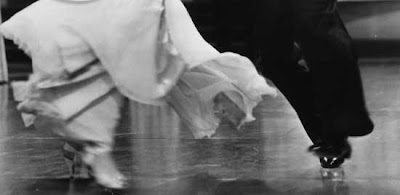 For no specific reason (other than the fact that I want to), this little essay is devoted to that artist with the most exotic of names, Hermès Pan.
For no specific reason (other than the fact that I want to), this little essay is devoted to that artist with the most exotic of names, Hermès Pan.Pan - born Hermès Panagiotopoulos on 10 December 1909 in Memphis, Tennessee - was (1) a movie choreographer extraordinaire, (2) Fred Astaire's house dance designer, (3) Astaire's near-doppelganger and (4) the man who, with Astaire, groomed the sublime Barrie Chase for a career on screen that could have rivaled Cyd Charisse's.
But Chase elected to retire young. Silly girl.
Actually, there is somewhat of a hook: "Flower Drum Song," one of the films choreographed by Pan during his most active period (and a recent inductee in the National Film Registry), airs tomorrow on Turner classics - Sunday, 18 January at 2:15 p.m., est.
Pan's glory days were in the 1930s when he worked with Astaire and Ginger Rogers in their great Art Deco musicals. But much later, between 1957 and 1973 and towards the end of his career, Pan was apparently the go-to guy for film choreography, overseeing 16 films in as many years:
"Pal Joey" (George Sidney, 1957)
"Silk Stockings" (Rouben Mamoulian, 1957)
"Never Steal Anything Small" (Charles Lederer, 1959)
"Porgy and Bess" (Otto Preminger, 1959)
"The Blue Angel" (Edward Dmytryk, 1959)
"Can-Can" (Walter Lang, 1960)
"Bells Are Ringing" (Vincinte Minnelli, 1960 - uncredited)
"The Pleasure of His Company" (George Seaton, 1961)
"Flower Drum Song" (Henry Koster, 1961)
"Cleopatra" (Joseph L. Mankiewicz, 1963)
"The Pink Panther" (Blake Edwards, 1963 - uncredited)
"My Fair Lady" (George Cukor, 1964)
"The Great Race" (Blake Edwards, 1965)
"Finian's Rainbow" (Francis Ford Coppola, 1968)
"Darling Lili" (Blake Edwards, 1970)
"Lost Horizon" (Charles Jarrott, 1973)
Both "Can-Can" and "Flower Drum Song," made a year apart, feature beautiful ballet sequences that can be considered companion pieces to one another. Regarding "Bells Are Ringing," although Charles O'Curran is listed as its choreographer, Hal Linden singles out Pan in his commentary on the film's DVD. My suspicion is that Pan quietly contributed the steps for the "Midas Touch" number which is performed in the movie by Linden (and is basically obscured in the background).
Pan also choreographed Astaire's three acclaimed TV specials - "An Evening with Fred Astaire" (1958), "Another Evening with Fred Astaire" (1959) and "Astaire Time" (1960), which is where Barrie Chase comes into the picture. After a few small roles in films such as Edmund Goulding's "Mardi Gras," she was Astaire's new dancing partner.
In '59, Pan was hired by Frank Sinatra to choreograph the aforementioned "Can-Can," and brought Chase along to play the second female lead, Claudine, the main can-can dancer. (Chase, Pan and Sinatra had all worked together on "Pal Joey.")
Chase ultimately bolted the production when most of her musical numbers were given to star Shirley MacLaine, as detailed in the DVD's liner notes.
MacLaine herself recounted this to Newsweek in its May 28, 1998/Sinatra Tribute issue in a piece carrying her byline.
Talking to Sinatra in the piece, she wrote: "You strong-armed Twentieth Century-Fox to make 'Can-Can' because you thought I should do a musical. And you had them combine the two female leads into a single character so people could see more of what I could do." That's only partially true. The character of Claudine was watered-down but still very much exists in the film. It was eventually recast with Juliet Prowse, who replaced the very wise Chase. Bad film, that "Can-Can."
Pan performed infrequently on screen (as a "specialty dancer") - most notably with both Betty Grable and Rita Hayworth - but for the most part enjoyed watching his terpsichorean creations from the wings. He died of a stroke at age 88 on 19 September 1990 in Beverly Hills.


(Artwork: Hermès Pan kicks it up with Betty Grable in Walter Lang's "Coney Island")
No comments:
Post a Comment